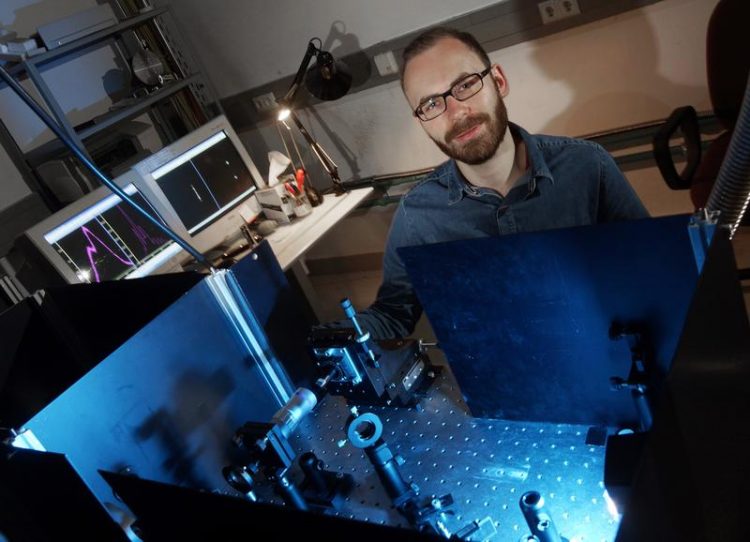Semiconductor nano-lasers: Speed at its limits

PhD student Robert Röder from the University of Jena achieved together with colleagues from Imperial College London the maximum possible speed at which a semiconductor laser can be operated. Photo: Jan-Peter Kasper/FSU
One thousand billion operations per second – this peak value is achieved by semiconductor nano-lasers developed by physicists at the University of Jena together with their colleagues from Imperial College London. As the researcher report in the current issue of the journal of „Nature Physics“, they are capable of producing the fastest lasers to date (DOI: 10.1038/NPHYS3103).
The fastest, in this case means the speed at which the laser can be turned on and off and not the length of laser pulse, as Prof. Dr. Carsten Ronning from the University of Jena clarifies. “While the fastest lasers typically need several nanoseconds for one cycle our semiconductor nano-laser only needs less than a picosecond and is therefore a thousand times faster,“ the solid state physicist continues.
For their nano lasers the researchers use tiny wires made of zinc oxide. These wires have diameters of a few hundreds of nanometres – around a thousandth of the diameter of human hair – and are about a few micro meters long. Their properties make these nanowires an active laser medium and a resonator at the same time.
“Light is being reflected at the ends of the nanowire, similar to a mirror, and is then amplified while propagating through the nanowire,“ says Robert Röder. The PhD student in Prof. Ronning’s team is one of the authors on this current publication.
For the researchers the concept of using nanowires as a laser is not new. However, the new idea in this publication is the possibility to fundamentally modify the speed of these lasers. To this end the physicists combined the semiconductor with a metallic layer, leaving only a 10 nanometer thin gap layer between both in which the light field is constricted.
“This is how light-matter interactions are accelerated,“ says Robert Röder. This is not only “world record“ regarding the switching speed. “Most likely we also achieved the maximum possible speed, at which such a semiconductor laser can be operated“.
Applications for these ultrafast und nanometre small lasers are especially optical transistors and sensors. “Using such tiny sensors single molecules or microbes can be detected in medical diagnostics“, emphasizes Prof. Ronning.
Original-Publication:
Sidiropoulos TPH et al. Ultrafast plamonic nanowire lasers near the surface plasmon frequency, NATURE Physics 2014 (DOI: 10.1038/NPHYS3103)
Contact:
Prof. Dr. Carsten Ronning, Robert Röder
Institute for Solid State Physics
Friedrich Schiller University Jena
Helmholtzweg 5, 07743 Jena
Germany
Phone: ++49 3641 / 947300, ++49 3641 / 947318
Email: carsten.ronning[at]uni-jena.de, robert.roeder[at]uni-jena.de
Media Contact
All latest news from the category: Physics and Astronomy
This area deals with the fundamental laws and building blocks of nature and how they interact, the properties and the behavior of matter, and research into space and time and their structures.
innovations-report provides in-depth reports and articles on subjects such as astrophysics, laser technologies, nuclear, quantum, particle and solid-state physics, nanotechnologies, planetary research and findings (Mars, Venus) and developments related to the Hubble Telescope.
Newest articles

Economies take off with new airports
A global study by an SUTD researcher in collaboration with scientists from Japan explores the economic benefits of airport investment in emerging economies using nighttime satellite imagery. Be it for…

CAR T–cell immunotherapy targets
Pan-cancer analysis uncovers a new class of promising CAR T–cell immunotherapy targets. Scientists at St. Jude Children’s Research Hospital found 156 potential CAR targets across the brain and solid tumors,…

Stony coral tissue loss disease
… is shifting the ecological balance of Caribbean reefs. The outbreak of a deadly disease called stony coral tissue loss disease is destroying susceptible species of coral in the Caribbean…





















